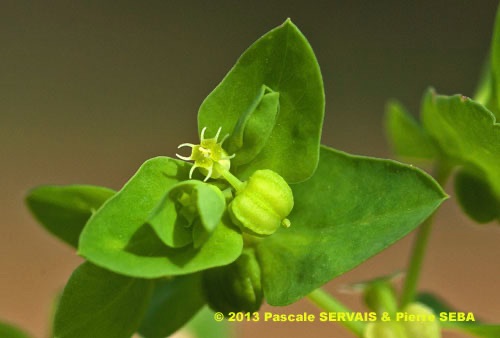
Euphorbia peplus L.
Fam. : Euphorbiaceae
© Pascale SERVAIS & Pierre SEBA, 2019. Tilo Botanica: Flore de Tilos et du Dodécanèse / Flora of Tilos and of the Dodecanese
English translation by Brenda Bradbury, Howard Bradbury and Stéphane Léonard
Plante herbacée, monoïque, à tiges vertes devenant rougeâtres, glabres, dressées, ramifiées dès la base, libérant un suc laiteux quand on les coupe.
Feuilles alternes, simples, ovales à orbiculaires, minces, molles, non dentées, glabres, à pétiole court, de 5 à 25 mm de long.
Fleurs à symétrie radiaire, vert jaunâtre, réunies en ombelles à 3 rayons principaux qui se ramifient jusqu’à 3 ou 4 fois en fourches successives, avec à la base des bractées vertes, triangulaires à ovales. Cyathe composé d’une fleur femelle à ovaire pendant, de plusieurs fleurs mâles et de glandes nectarifères réniformes, à cornes fines, allongées, finement aiguës. Ovaire supère.
Fruits, capsules à 3 graines, poilues, en forme de baies, de 3 mm de diamètre, lisses, à 2 côtes au dos de chaque valve. Graines gris pâle, cannelées.
___________________________
Plant herbaceous, monoecious. Stems green becoming reddish, glabrous, erect, branched from the base, releasing a milky sap when cut.
Leaves alternate, simple, ovate to orbicular, thin, soft, nontoothed, glabrous, with a short petiole, from 5 to 25 mm long.
Flowers radially symmetrical, yellowish green, joined together in umbels with 3 main rays which ramify up to 3 or 4 times in successive forks, with green, triangular to ovate bracts at the base. Cyathium made up of a female flower with a hanging ovary, surrounded by several male flowers and kidney-shaped nectariferous glands, with thin, lengthened, finely acute horns. Ovary superior.
Fruits, hairy capsules with 3 seeds, in the shape of berries, 3 mm in diameter, smooth, with 2 ribs at the back of each valve. Seeds pale grey, grooved.
Descripteurs / Identifying features
1
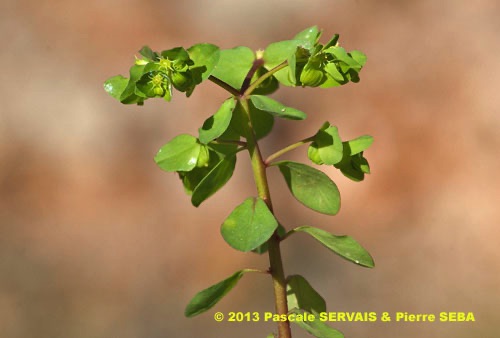
2
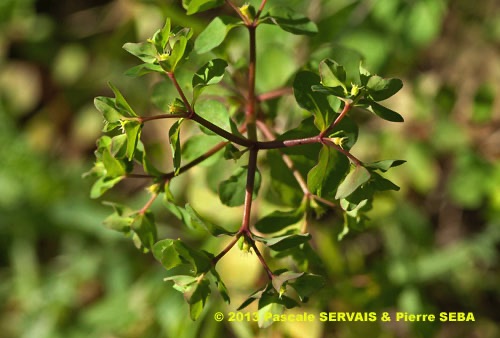
3
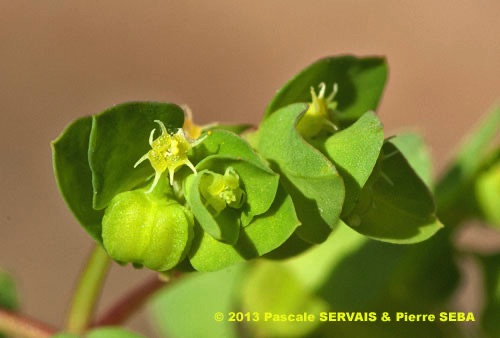
4
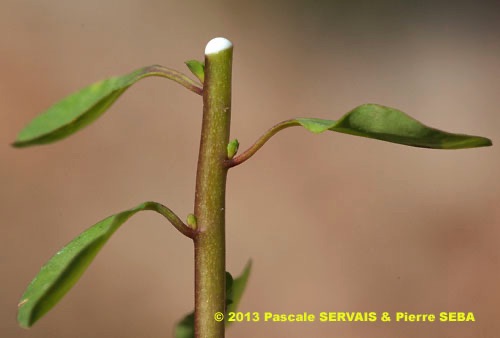
5
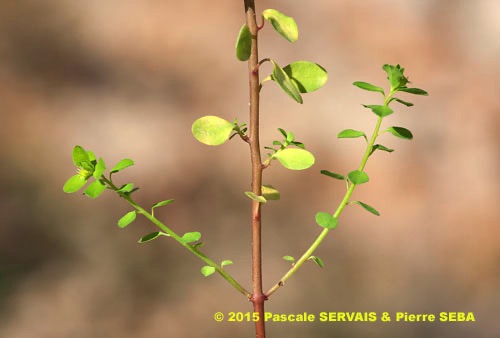
6
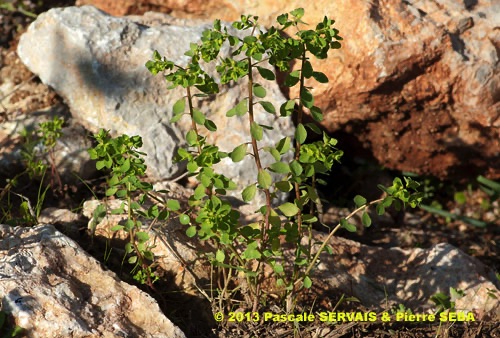
7
Étymologie / Etymology :
Euphorbia : emprunt du latin euphorbia, -ae (nom), nom donné à la
plante par Pline, naturaliste latin mort en 79 apr. J.-C., forme latinisée
du grec ancien εὐφόρβιον, -ου (nom) [ < εὖ (adv.) = bien +
φέρβω (verbe) = nourrir ] = bien nourri, gras, nom donné à la plante
par Dioscoride, médecin et botaniste grec mort en 90 apr. J.-C.
OU
nom donné en l’honneur d’Euphorbe, médecin du roi Juba de
Mauritanie au 1er siècle après J.-C.
Peplus : emprunt du latin peplum / peplus, -i (nom) = le voile, la
robe, le vêtement, forme latinisée du grec ancien πέπλος, -ου (nom)
= le voile, le vêtement, nom donné à la plante par Dioscoride, médecin
et botaniste grec mort en 90 apr. J.-C., en référence au port étalé de
la plante dont les feuilles recouvrent le sol comme un voile.
Euphorbia : borrowed from Latin euphorbia, -ae (noun), name given to
the plant by Plinius, Latin naturalist died in 79 AD, Latinized form of
the Classical Greek εὐφόρβιον, -ου (noun) [ < εὖ (adv) = well +
φέρβω (verb) = to feed ] = well fed, fat, name given to the plant by
Dioscorides, Greek doctor and botanist died in 90 AD.
OR
name given in honour of Euphorbos, doctor of king Juba of Mauritania
in the 1st century AD.
Peplus : borrowed from Latin peplum / peplus, -i (noun) = veil, dress,
clothing, name given to the plant by Dioscorides, Greek doctor and
botanist died in 90 AD, referring to the wide-spreading habit of the
plant whose leaves cover the ground like a veil.
Synonymes / Synonyms :
Esula rotundifolia Gray
Keraselma oleracea Raf.
Keraselma peplus (L.) Raf.
Tithymalus peplus (L.) Gaertn.
Tithymalus rotundifolius Lam.
Noms vernaculaires / Common names :
Noms français / French names :
Ésule ronde — Euphorbe des jardiniers — Euphorbe des jardins —
Euphorbe des vignes — Euphorbe omblette — Euphorbe péplus.
Noms grecs / Greek names :
Γαλατσίδα — Γαλατσίδα μικρή — Ευφόρβιες —
Ευφόρβιον ο πέπλος — Μικρή γαλατσίδα.
Noms anglais / English names :
Petty spurge — Radium plant.
Noms allemands / German names :
Garten Wolfsmilch — Garten-Wolfsmilch — Gartenwolfsmilch.
Noms espagnols / Spanish names :
Ésula redonda — Lecheriega — Lecherina — Lechetrezna reduela —
Lechetreznilla — Peplo — Rechitierna de sombrilla —
Tesula redonda — Titímalo — Tomagallos.
Noms italiens / Italian names :
Calenzuola piccola — Euforbia minore.
Habitat :
Cultures - Lieux pierreux - Lieux incultes - Lieux humides, mares -
Chemins.
Cultivated places - Stony places - Waste ground - Damp places, ponds -
Waysides.
Île / Island :
Tilos.
Hauteur / Height range :
De 10 cm à 50 cm.
From 10 cm to 50 cm.
Floraison / Flowering time :
De janvier à septembre.
From January to September.
Groupe / Classification :
Dicotylédones.
Dicotyledons.
Pérennité / Lifespan :
Annuelle.
Annual.
Description :
Clés dichotomiques et descripteurs distinctifs des 13 espèces / Dichotomous keys and distinctive identifying features of the 13 species
Photo 1 :
Localisation / Location : Tilos, Megalochorio, Plaine d’Erystos
Date : 25/01/2013
GPS : Lat. 36,44563° N / Long. 27,34960° E / Alt. 24 m
Type : Photographie numérique / Digital Photograph (10 mégapixels)
Photo 2 :
Localisation / Location : Tilos, Livadia, Village
Date : 14/01/2013
GPS : Lat. 36,41893° N / Long. 27,38586° E / Alt. 23 m
Type : Photographie numérique / Digital Photograph (10 mégapixels)
Photo 3 :
Localisation / Location : Tilos, Livadia, Village
Date : 14/01/2013
GPS : Lat. 36,41893° N / Long. 27,38586° E / Alt. 23 m
Type : Photographie numérique / Digital Photograph (10 mégapixels)
Photo 4 :
Localisation / Location : Tilos, Livadia, Village
Date : 14/01/2013
GPS : Lat. 36,41893° N / Long. 27,38586° E / Alt. 23 m
Type : Photographie numérique / Digital Photograph (10 mégapixels)
Photo 5 :
Localisation / Location : Tilos, Livadia, Village
Date : 14/01/2013
GPS : Lat. 36,41893° N / Long. 27,38586° E / Alt. 23 m
Type : Photographie numérique / Digital Photograph (10 mégapixels)
Photo 6 :
Localisation / Location : Tilos, Livadia, Village
Date : 14/01/2013
GPS : Lat. 36,41893° N / Long. 27,38586° E / Alt. 23 m
Type : Photographie numérique / Digital Photograph (10 mégapixels)
Photo 7 :
Localisation / Location : Tilos, Livadia, Village
Date : 14/01/2013
GPS : Lat. 36,41893° N / Long. 27,38586° E / Alt. 23 m
Type : Photographie numérique / Digital Photograph (10 mégapixels)
Photo 8 :
Localisation / Location : Tilos, Livadia, Aghios Stephanos
Date : 02/04/2019
GPS : Lat. 36,41107° N / Long. 27,40092° E / Alt. 3 m
Type : Photographie numérique / Digital Photograph (24 mégapixels)
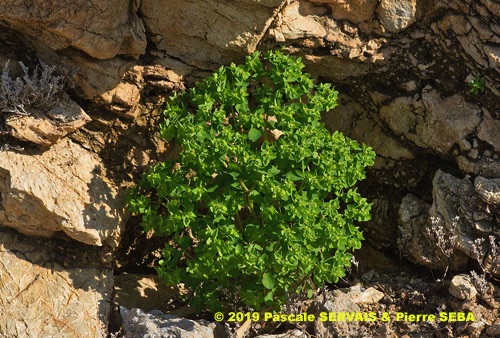
8

Google Maps
Google Maps
Google Maps
Google Maps
Google Maps
Google Maps
Google Maps
Google Maps